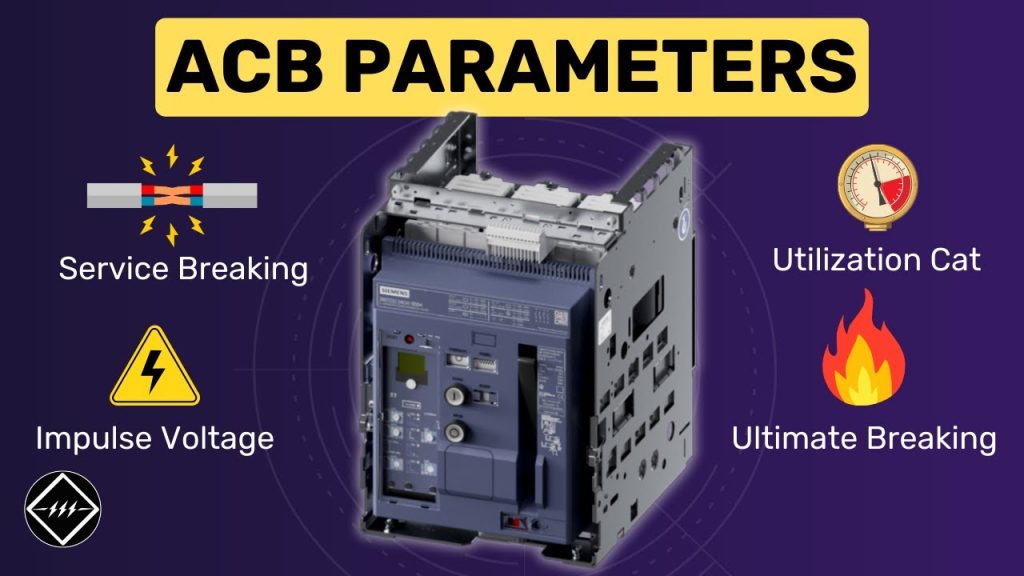
Understanding Air Circuit Breaker Parameters Step by Step
Understanding Air Circuit Breaker Parameters Step by Step https://www.theelectricalguy.in/wp-content/uploads/2025/10/maxresdefault-4-1024x576.jpg 1024 576 Gaurav Joshi Gaurav Joshi https://secure.gravatar.com/avatar/8d621b67d3005addbda23477c1259921ee1db2decf01a4f473bf0e5c76f3933a?s=96&d=mm&r=gAir Circuit Breakers, or ACBs, are one of the most important components in low voltage switchgear. To use them effectively, you must understand their technical parameters. These parameters are listed in the product datasheet or specifications and tell you what the ACB can handle.

In this article, we will go through all Air Circuit Breaker Parameters You MUST Know in a simple and clear way. Each point will help you understand what the values in a datasheet mean and why they matter in real applications.
Table of Contents
- Rated Service Voltage (Ue)
- Rated Insulation Voltage (Ui)
- Rated Impulse Withstand Voltage (Uimp)
- Rated Frequency
- Fixed Type and Withdrawable Type ACBs
- Suitability for Isolation (IEC 60947-2)
- Rated Uninterrupted Current (Iu) at 40°C
- Neutral Pole Current Carrying Capacity
- Rated Ultimate Short Circuit Breaking Capacity (Icu)
- Rated Service Short Circuit Breaking Capacity (Ics)
- Rated Short Circuit Withstand Current (Icw)
- Rated Short Circuit Making Current (Ip)
- Utilization Category (A or B)
- Why These Parameters Matter
- Final Thoughts
Rated Service Voltage (Ue)
The first parameter is the rated service voltage (Ue). It defines the voltage for which the circuit breaker is designed.
For example, an ACB can have ratings like 800 V, 900 V, or 1,000 V. This is the normal operating voltage that the breaker can handle safely and continuously without any issue.
This value tells you how much voltage the ACB can carry during regular operation.
Rated Insulation Voltage (Ui)
The next parameter is the rated insulation voltage (Ui). This is the maximum voltage that the insulation of the circuit breaker can withstand.
It ensures safety when there is a voltage rise in the system that lasts for some time. For example, if a circuit breaker has an insulation voltage of 1,000 V, it means the breaker can safely handle that voltage without insulation failure.
This value proves that the ACB is tested and certified to handle voltage surges under normal and abnormal conditions.
Rated Impulse Withstand Voltage (Uimp)
Another important parameter is the rated impulse withstand voltage (Uimp). It shows how much sudden high voltage, called an impulse voltage, the breaker can withstand.
Impulse voltages can occur due to lightning strikes, load changes, or sudden faults. For example, if the ACB has a Uimp rating of 12 kV, it means it can handle up to 12 kilovolts of impulse without damage.
This rating ensures the breaker is tested for impulse endurance and can protect the system from such transient spikes.
Rated Frequency
The rated frequency shows the frequency for which the ACB is designed. Usually, breakers can operate at either 50 Hz or 60 Hz, depending on the country.
This rating indicates the power frequency suitability of the circuit breaker.
Fixed Type and Withdrawable Type ACBs
ACBs come in two main types fixed type and withdrawable type.
The fixed type ACB stays permanently mounted inside the panel. It cannot be removed unless you manually unbolt it. It remains fixed in one position during operation.

The withdrawable type, on the other hand, can be easily removed from the panel. You can rack it out and replace it with another breaker when needed.

Withdrawable types use an extra metal frame for this mechanism. While they may be bulkier, they offer flexibility during maintenance or replacement. Both types have their advantages and are used based on the system design.
Suitability for Isolation (IEC 60947-2)
Next, we have suitability for isolation, defined by IEC 60947-2.
In high or medium voltage systems, isolators are used for visible disconnection. They show when a circuit is open and safe to work on.
However, in low voltage systems, separate isolators are not always needed. A circuit breaker can act as an isolator if it provides a clear visual indication that the circuit is open.
Withdrawable ACBs offer visible isolation when removed from the panel. The IEC standard ensures the breaker gives reliable and clear isolation indication.
You can identify such breakers by their symbol. Normally, the circuit breaker symbol has a switch with a cross. When suitable for isolation, it includes an extra horizontal line.
This feature ensures operators can work safely with full confidence that the power supply is off.
To understand this concept in depth including when and how to select an isolator or withdrawable ACB you can explore the Low Voltage Switchgear Level 2 course by TheElectricalGuy. The course explains isolation principles, breaker selection, and IEC standards with detailed visuals and examples.
Rated Uninterrupted Current (Iu) at 40°C
The rated uninterrupted current (Iu) shows how much current the breaker can carry continuously at a specific ambient temperature.
For example, if the ACB is rated at 1,250 A at 40°C, it means the breaker can carry 1,250 amperes continuously when the surrounding temperature is 40°C.
If the temperature exceeds 40°C, the breaker’s capacity may reduce. In that case, you must apply a derating factor to calculate the new value.
This parameter ensures that the ACB operates safely under rated temperature conditions without overheating.
Neutral Pole Current Carrying Capacity (for 4-Pole Breakers)
In a four-pole circuit breaker, the fourth pole is for the neutral connection.
The neutral pole current carrying capacity shows how much current the neutral pole can carry compared to the other poles.
For example, if the ACB rating is 1,250 A and the neutral rating is 100%, the neutral can also carry 1,250 A.
However, for larger ratings like 6,300 A, the neutral may only handle 50% of that. This is because very high neutral currents are rare in such systems.
This parameter helps in selecting the right breaker for systems that require a neutral connection.
Rated Ultimate Short Circuit Breaking Capacity (Icu)
One of the most critical parameters is the rated ultimate short circuit breaking capacity (Icu).
This value indicates the maximum short circuit current the breaker can interrupt safely.
For example, if an ACB is rated at 35 kA for 800 V, it means it can safely break a short circuit current of 35 kiloamperes.
However, after interrupting such a fault, the breaker may not remain reusable. The reusability of the breaker after an ultimate short circuit is not guaranteed.
This parameter follows IEC standards and shows the limit beyond which the breaker should be replaced even if it successfully interrupts the fault.
Rated Service Short Circuit Breaking Capacity (Ics)
The rated service short circuit breaking capacity (Ics) is another important parameter closely related to Icu.
It indicates the short circuit current that the breaker can interrupt and then continue to operate normally afterward.
For instance, if the service breaking capacity is 100% of the ultimate capacity, it means the breaker can trip and then be reused safely.
In some cases, the service capacity is lower for example, Icu may be 100 kA while Ics is 75 kA.
Understanding the difference between Icu and Ics helps you know how many times and under what conditions a breaker can be reused after fault interruption.
Rated Short Circuit Withstand Current (Icw)
The rated short circuit withstand current (Icw) shows how much short circuit current the breaker can carry for a short duration without damage.
This duration is usually 1 second or 3 seconds.
For example, if a breaker can withstand 35 kA for 1 second and 30 kA for 3 seconds, it means the breaker can safely carry that current for those specific durations.
This rating ensures that the breaker can handle fault currents until protection devices trip and isolate the circuit.
Rated Short Circuit Making Current (Ip)
The rated short circuit making current (Ip), also known as the peak current, is another key parameter.
During the first few cycles of a short circuit, the current can rise to very high levels for a short time.
This peak value may reach up to 2.5 times the rated short circuit current, depending on the system frequency (50 Hz or 60 Hz).
The breaker must withstand this high peak value without mechanical or electrical damage.
This ensures the ACB remains stable during the first moments of a fault when the current surge is at its maximum.
Utilization Category (A or B)
The utilization category defines how the breaker responds during faults.
Most air circuit breakers belong to category B.
Category B breakers can delay tripping to coordinate with downstream devices. This means they wait briefly to let a smaller breaker trip first. If that fails, the main breaker trips next.
This delay helps maintain service continuity and prevents unnecessary shutdowns.
In contrast, category A breakers, like those in homes, trip immediately without delay. They are used where instant protection is needed.
For low voltage and industrial systems, category B breakers are preferred due to their selectivity and coordination benefits.
Why These Parameters Matter
Every ACB parameter defines a specific capability of the breaker.
Together, they ensure that the breaker operates safely, efficiently, and reliably under all expected conditions.
Knowing these parameters helps engineers select the right circuit breaker for a system, avoiding risks like overheating, insulation failure, or unwanted tripping.
Each value in the datasheet represents a tested limit, confirming that the ACB meets IEC standards and can perform as expected in the field.
Final Thoughts
Understanding these Air Circuit Breaker Parameters You MUST Know is essential if you work with low voltage switchgear systems.
Each parameter from voltage ratings to short circuit capacities plays a key role in ensuring safe and efficient operation.
For a detailed, practical understanding of these concepts including breaker selection, testing, and real-world applications check out the Low Voltage Switchgear Level 2 course by TheElectricalGuy.
It covers ACBs, MCCBs, isolation principles, and protection coordination in a structured, easy-to-learn way.
Watch the complete course here
If you prefer a quick visual explanation, also watch the video “Air Circuit Breaker Parameters You MUST Know” on YouTube. It breaks down every concept with clarity and visuals.
Keep learning and exploring understanding your equipment in depth is the best way to ensure safety and reliability in every electrical system.

- Posted In:
- Tutorials
Gaurav Joshi
Gaurav, also known as TheElectricalGuy, is an accomplished electrical engineer with over 8 years of experience in the high and medium voltage switchgear industry. In addition to his professional endeavors, Gaurav has made significant contributions to the global electrical engineering community through his highly successful YouTube Channel. With over 195K subscribers and a prestigious silver play button from YouTube, he has become a trusted resource for electrical engineers worldwide. Gaurav's dedication to sharing knowledge extends to the creation of comprehensive courses, which have already attracted over 3000 students eager to enhance their skills in the field.
All stories by: Gaurav Joshi

